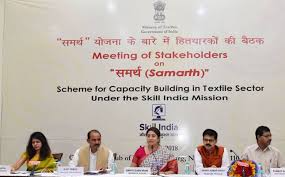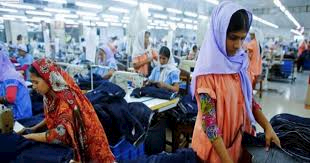Samarth Scheme: A Comprehensive Guide for Skill Development in India

The Samarth Scheme is a major initiative launched by the Indian Government to create a skilled workforce in the textile sector. The scheme aims to provide training and employment to millions of people across the country and enhance their skills to meet the demands of the industry. In this article, we will discuss the various aspects of the Samarth Scheme, its objectives, and its impact on the textile industry.
Introduction
Samarth is a demand driven and placement-oriented umbrella skilling programme of Ministry of Textiles. The implementation period of the scheme is up to March 2024. The scheme was formulated under the broad skilling policy framework adopted by M/o Skill Development & Entrepreneurship. The textile industry is one of the largest industries in India, employing millions of people across the country.

However, despite its huge potential, the sector faces several challenges such as the lack of skilled workers, outdated technology, and stiff competition from other countries. The Samarth Scheme was launched in 2018 to address these issues and provide a skilled workforce to the industry.
Samarth aims to incentivize and supplement the efforts of the industry in creating jobs in the organized textile and related sectors, covering the entire value chain of textiles, excluding Spinning and Weaving. Read also- PM Mitra Parks
The training programme and course curriculum have been rationalized keeping in view the technological and market demands of the domestic and international economies.
In addition to the entry level skilling, a special provision for upskilling/ re-skilling programme has also been operationalized under the scheme towards improving the productivity of the existing workers in Apparel & Garmenting segments. Samarth also caters to the upskilling/ re-skilling requirement of traditional textile sector such as handloom, handicraft, silk and jute.
Objectives of the Samarth Scheme
The primary objective of the Samarth Scheme is to develop a skilled workforce for the textile sector and increase its productivity and competitiveness. The scheme aims to achieve the following objectives:
- To provide training and employment to millions of people across the country.
- To enhance the skills of existing workers and enable them to adopt modern technologies and processes.
- To create a pool of certified skilled workers to meet the demand of the industry.
- To promote entrepreneurship and self-employment in the sector.
- To improve the working conditions and welfare of workers in the industry.
Components of the Samarth Scheme

The Samarth Scheme has four main components, which are:
Skill Training
Under this component, the scheme provides training to workers in various areas such as spinning, weaving, processing, knitting, garment making, etc. The training is imparted through various modes such as classroom sessions, on-the-job training, and e-learning modules.
Upgradation of Traditional Skills
This component aims to preserve and promote traditional skills in the textile sector. The scheme provides support for the upgradation of traditional skills and techniques such as handloom weaving, dyeing, printing, etc. This helps in preserving the cultural heritage of the country and also promotes eco-friendly practices.
Skill Certification
The scheme provides certification for the skills acquired by workers under the scheme. The certification is provided through recognized institutions and helps in creating a pool of certified skilled workers in the industry.
Support for Employability
This component provides support for the placement and employability of workers. The scheme provides support for apprenticeships, job fairs, and entrepreneurship development programs. This helps in creating employment opportunities for skilled workers and promotes self-employment in the sector.
Eligibility Criteria for the Scheme
The Samarth Scheme is open to all individuals, institutions, and organizations in the textile sector. The scheme provides support for training, up gradation of skills, certification, and employability to workers in the sector.
Implementation of the Scheme
The Samarth Scheme is implemented by the Ministry of Textiles through various agencies such as the National Skill Development Corporation (NSDC), State Skill Development Missions (SSDMs), and sector-specific organizations. Read also- PM UMEED SCHEME
The scheme is implemented in a decentralized manner, with the involvement of various stakeholders such as industry associations, training providers, and employers.
Impact of the Samarth Scheme
The Samarth Scheme has had a significant impact on the textile sector in India. Since its launch in 2018, the Samarth Scheme has provided training to over 5.5 lakh workers and created employment opportunities for over 2.5 lakh people in the textile sector.
The scheme has also helped in enhancing the skills of existing workers and enabled them to adopt modern technologies and processes.
The scheme has been particularly beneficial for women, as it has provided them with opportunities for skill development and employment. The scheme has also helped in promoting entrepreneurship and self-employment in the sector. Read more- PIB
The scheme has also contributed to the growth and competitiveness of the textile industry in India. The skilled workforce created under the scheme has helped in improving the quality and productivity of the industry and enabled it to compete with other countries in the global market.
Challenges Faced by the Scheme

The Samarth Scheme faces several challenges in its implementation. One of the major challenges is the lack of awareness among workers and employers about the scheme and its benefits. This has led to a low uptake of the scheme in some regions.
Another challenge is the lack of adequate infrastructure and training facilities in some parts of the country. This has made it difficult to provide training and certification to workers in those regions.
Future Prospects of the Scheme
The Samarth Scheme has the potential to transform the textile sector in India and create a skilled and competitive workforce. The government has allocated significant resources for the scheme, and its continued implementation is expected to have a positive impact on the sector.
In the future, the scheme is expected to focus on the upgradation of technology and processes in the sector and provide training for emerging areas such as technical textiles, digital printing, and sustainable practices.
Conclusion
The Samarth Scheme is a major initiative launched by the Indian Government to create a skilled workforce in the textile sector. The scheme has provided training and employment opportunities to millions of people across the country and enhanced the competitiveness of the industry. Despite facing several challenges, the scheme has made significant progress and has the potential to transform the sector in the future.
FAQs
What is the Samarth Scheme?
The Samarth Scheme is a government initiative launched to create a skilled workforce in the textile sector.
Who is eligible for the Samarth Scheme?
The Samarth Scheme is open to all individuals, institutions, and organizations in the textile sector.
What are the components of the Samarth Scheme?
The Samarth Scheme has four main components: skill training, upgradation of traditional skills, skill certification, and support for employability.
What is the impact of the Samarth Scheme?
The Samarth Scheme has provided training and employment opportunities to millions of people and enhanced the competitiveness of the textile industry in India.
What are the future prospects of the Samarth Scheme?
In the future, the scheme is expected to focus on the upgradation of technology and processes in the sector and provide training for emerging areas such as technical textiles, digital printing, and sustainable practices.
sourse – PIB